Mathematical Analysis of the Relationship Between the Steem Power and the Reputation in Steemit—How Much Does the Reputation Increase Based on the Votes Received?
The reputation in Steemit represents the value that reflects the quality of the content that each user shares. However, it is not directly related to the amount of Steem Power of each account (the amount of money invested in the platform). There are whales in Steemit with a low reputation and users who have little Steem Power and still have a high reputation value.
The present article will analyze from the mathematical approach how these two concepts are related in Steemit, their interrelations, and consequences. Firstly, we will study in detail the meaning of each of these concepts and their actual numerical values in the blockchain of Steemit.
The Steem Power (SP) is the Steem invested in the platform with the aim of increasing the value of each user's vote. In this sense, the SP allows earning higher healing rewards and gives a higher value to the publications voted. However, even when the Steem Power is reflected as equal to the Steem, its pure form is something known as Vesting Shares.
The Vesting Shares (VS) represent the actions that each user has within Steemit. That would be “The property,” as mentioned in the Steemit's White Book. This leads to a limited number of Vesting Shares since the more VS a user has, the greater healing rewards s/he will win.
We ask ourselves, “What is the correspondence between the Steem Power and the Vesting Shares?” The rate at which they are converted can be found on steemd.com
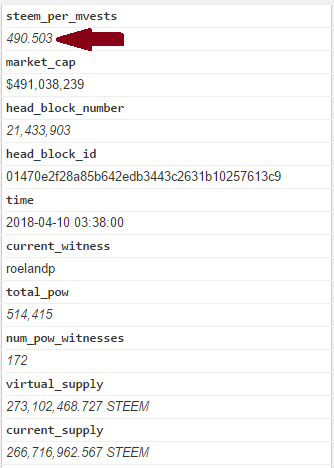
Pic.: Steem conversion rate by MVests. Source: steemd.com, as edited by the author.
Currently, the value of MVests (Millions of Vesting Shares) is of 490.471 Steem. This means that for each million of Vesting Shares 490.471 SP are obtained. To calculate the inverse rate, we must perform the following calculation:

This implies that each Steem Power can be converted into 2,038.857 Vesting Shares (VS). At the time of voting each curator contributes to the post reward a specific value which is measured in a unit called Reward Shares (RS). This value is calculated in the following way:

Here, Vp refers to the voting power that the curator has at that moment, a value that varies from 0% to 100% and decreases as one votes to recharge daily by 20%; Vs refers to Vesting Shares, the true form of the SP. To sum up, every time a user votes for a post, it adds a value of Reward Shares as expressed by the previous formula (as long as the user votes at 100% for if a voting with a lower weight is made, that percentage is calculated in Reward Shares).
In another order of ideas, the reputation is the value that is reflected next to the name of each user in parentheses and is used as an indicator of the quality and quantity of contributions of users in Steemit. A high reputation is associated with a user that has received a large number of high-value positive votes while a negative reputation—as a result of having received negative votes or banners.
All new users start with a reputation of 25 and from that value, they increase their reputation based on the number of favorable votes received by their publications and the global value of the upvotes received—the higher the reputation, the more visible an account will be. Although there is the option to display the publications of users with low reputation, publications with a very low reputation can be hidden in Steemit.
The Steemit blockchain handles the reputation internally as an integer called RAW SCORE. Based on this number, it calculates the reputation value that can be seen in each user's profile. The procedure to transform the RAW SCORE into the amount of the reputation is as follows:
1- The logarithm is calculated in base ten (10) RAW Score.
2- Subtract nine (9) from the result.
3- The obtained value is multiplied by nine (9).
4- Finally, we add 25 to the result to obtain the value of the reputation (If the formula generates a value of less than 25 for new users, it is taken to 25).
For example for a RAW Score of 957.234.174.807 (My current value) would be:
A) log10 (957,234,174,807) = 11.9810182
B) 11.9810182 - 9 = 2.981018195
C) 2.981018195 * 9 = 26.82916376
D) 26.82916376 + 25 = 51.82916376
The obtained value is rounded to 51.8 which would be my current reputation.
Generalizing this procedure, we will get the corresponding formula:

Where:
“Rep” stands for “Reputation”
“RAW” stands for “RAW SCORE”
To simplify it:


This is the general formula to calculate the reputation from RAW SCORE. To obtain the inverse formula, we will clear the variable RAW:



This expression allows you to calculate the SCORE RAW from a given reputation. The table below will show the relationship between the reputation and the RAW:
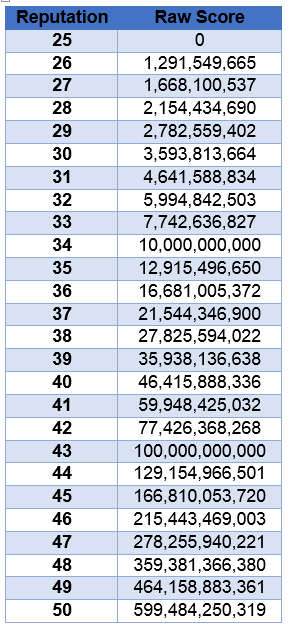
Table N° 1: Correspondence between Reputation and Raw Score.
Source: @ydavgonzalez.
At this point, it is essential to analyze what is the relationship between the value of a received vote (which is proportional to the SP) and the increase generated in the RAW Score (the true form of the reputation). In this way, we can calculate the contribution of each voter to the reputation of an author, and the respective conversion rate between the Reward Shares and the RAW Score.
To make this measurement, I take as a reference my account @ydavgonzalez for a vote made to the @isgledysduarte account. The obtained result is reflected in the table below:
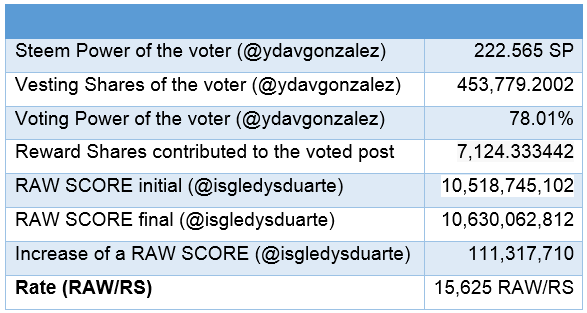
Table N° 2: Analysis of the increase of the Raw Score at voting (Ex. N° 1). Source: @ydavgonzalez
The increase of the Raw Score is calculated after the vote and the Rewards Shares received to finally establish the relationship between both values. This value was verified in a second measurement:
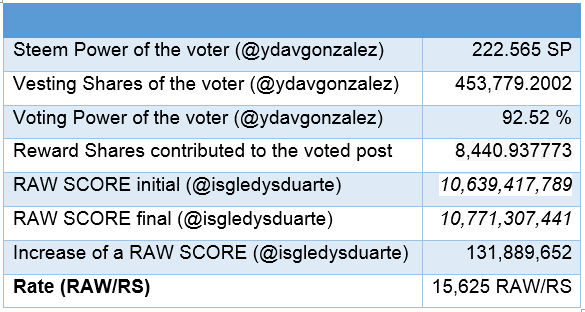
Table N° 3: Analysis of the increase of the Raw Score at voting (Ex. N° 2). Source: @ydavgonzalez
Based on the data collected from the blockchain of Steemit, the following conclusion is established:
For each Reward Share received in a publication, the RAW Score increases 15,625 points.
As the Reward Shares are in direct relation with the Vesting Shares, a relationship is established between the Steem Power of the account that has voted (Vesting Shares) and the increase in the reputation of the user who receives the vote (RAW Score).
Let’s see again the formula to calculate Reward Shares:

For a user who votes with a voting power of 100%, it is true that:
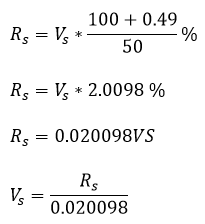
At the current rate, it should be remembered that 1 SP = 2,038.857 VS. With this data one can establish a relationship between the increases in the reputation received by each user and the total Reward Shares of one’s publications, building the following reference table.
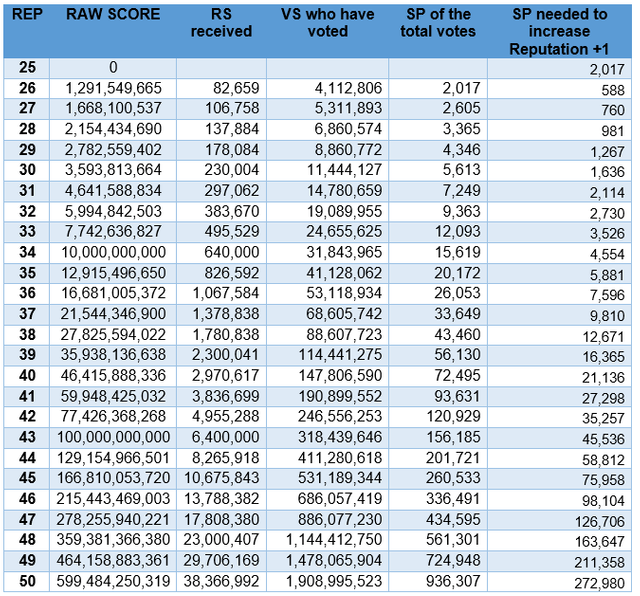
Table N° 4: Analysis of the relationship between Reward Shares and Raw Score. Source: @ydavgonzalez
Table N° 4 contains valuable information to study the correlation between the votes received and the increase in reputation. It can be interpreted as follows:
• The first two columns refer to the reputation as shown in Steemit and the internal value RAW SCORE.
• The third column shows the Reward Shares that a user must have received to reach a certain level of reputation.
• The fourth column shows the value of the Vesting Shares of the curators who must have upvoted a user so that the user reaches the corresponding reputation value (making the appropriate corrections based on the voting power and weight with which they voted).
• The fifth column shows the total sum of Steem Power with which the user has been voted for each level of reputation.
• The last column shows the sum of the Steem Power of the curators that a user located at a certain level of reputation needs to raise it by 1 level.
Based on this table one can see that if a curator with 21,136 Steem Power votes (with 100% weight and voting power of 100%) upvotes a new user, the reputation of that user will increase to 40 points. But for a new user to reach 50 reputation points with a single vote, the curator who votes must have at least 936,307 Steem Power which is a fairly large number that few users have.
It can also be observed that despite the fact that the value of the rewards fluctuates over time (the value of the vote of the same user can vary over time even if said user maintains a constant Steem Power), the increase of the Raw Score generated by a user with a continuous Steem Power is also constant.
Concerning negative votes, banners or flags, they have the opposite effect on the reputation of the user who receives the vote. Those decrease the reward to be obtained and the Raw Score; the Raw Score decreases as long as the user who gives the negative vote has more reputation than the user who receives it. If a user with reputation 30 receives a negative vote from another user with 5,613 Steem Power, s/he would see her/his reputation decrease to 25 points as it can be deduced from table N° 4. Nonetheless, if the user who gives the flag has a reputation lower than 30, it will not affect the reputation of the user who receives the negative vote although the Reward Shares will be affected and therefore also the reward of the post.
Analyzing this last point, one can understand the great difficulty that the community would face if we were to reduce the reputation of a user who has high value of Raw Score and commits abuses because a user with a high reputation can only see his reputation reduced if he receives negative votes of a user with an even higher reputation than him.
CONCLUSIONS
Although there is no direct relationship between the Steem Power and the reputation in Steemit, an indirect connection can be established because a user with a high value of Steem Power, if s/he proceeds to auto-vote, will be generating an increase of her/his own reputation.
In addition to the previous fact, accounts with large values of Steem Power tend to attract more followers and votes due to the net effect of money, which in the long term causes an increase in the reputation of the user.
When a user votes an article brings a certain amount of Reward Shares to that article, although the value in SBD of the reward may fluctuate the value in Reward Shares is constant.
REFERENCES
- Steemit Inc (2017) Steem Whitepaper. Available at https://steem.io/steem-whitepaper.pdf
Translated from Spanish to English by @me422us • May 26, 2018.

Oye excelente análisis. Hace tiempo que quería estudiar esta relación. Hubiera sido perfecto que lo pudieras ligar con el código fuente y sus fórmulas.
Me he entretenido mucho viendo la última tabla, da una información muy interesante que nunca había visto. ¿Podrías llevarla hasta una reputación de 80? A todos nos pica la curiosidad.
Un saludo.
Gracias, debo dedicarle tiempo a revisar con calma el código fuente, debido a que algunas secciones son confusas para mi. Aquí incluyo la tabla ampliada hasta una reputación de 80
Ver en una resolución mayor. Fuente: Elaboración propia
Para los hispanohablantes:
¿Puedes vincular el código fuente y sus fórmulas? Si todos colaboramos, los artículos serían mejores y más informativos y podemos llegar a más personas para que también puedan contribuir en lugar de escribir fragmentos aquí y allá. Ayudaré a traducir y luego a organizarlos para su publicación. Estoy organizando un equipo para STEM, IT, escritores técnicos competentes, todos los idiomas, donde sea que estés, siempre y cuando seas serio y receptivo. Sin embargo, solo se aceptan obras originales. El equipo de preaprobación está aquí @Discord→ https://discord.gg/8gtfrwm ¡Piénsalo! ∜mp
For the anglophones:
Can you link the source code and its formulas? If we all collaborate, the articles would be better and more informative and we can reach more people so that they can also contribute instead of writing fragments here and there. I will help translate and then organize them for publication. I am organizing a team for STEM, IT, competent technical writers, all languages, wherever you are, as long as you are serious and receptive. However, only original works are accepted. The preapproval team is here @Discord → https://discord.gg/8gtfrwm Think about it! ∜mp
Thank you for translating this excellent article!
Para los hispanohablantes:
¡Hola, @ydavgonzalez! ¡Gran trabajo! Tal como se dijo anteriormente, he creado un equipo de aprobación previa en @Discord → https://discord.gg/8gtfrwm. Únase allí y lo trasladaré al equipo de trabajo. ¡Saludos! ∜mp
For the anglophones:
Hi, @ydavgonzalez! Great @originalworks! As spoken earlier, I've created a preapproval team on @Discord → https://discord.gg/8gtfrwm Join there, and I'll move you to the working team. Cheers! ∜mp
Gracias por el apoyo, allí estaré.
Congrats! This is an excelent analysis. Keep it going with post like that.
Thank you for your contribution!
Good Fortune